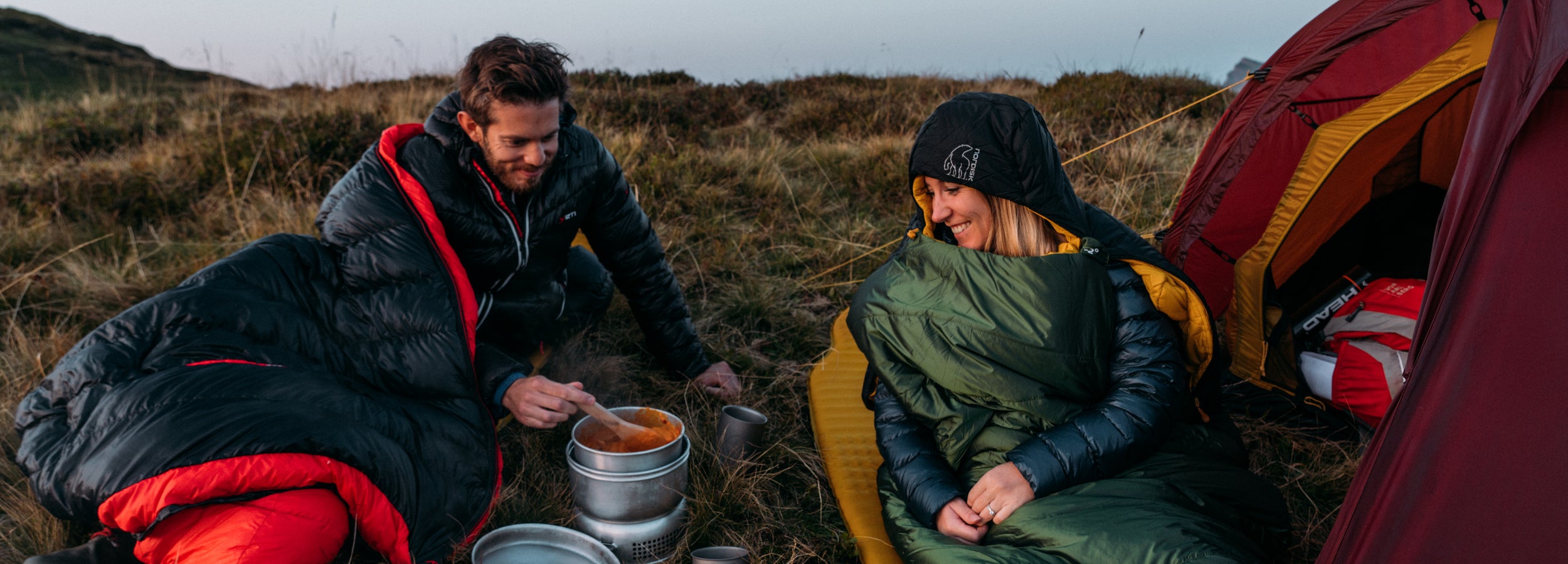


Whether you sleeping bag in insulated with Down or Synthetic fibres, there are a number of things you can do to improve its performance and its lifecycle – essentially giving you more and better nights of sleep inside.
Follow this simple guide to having great nights in a sleeping bag and make your sleeping bag last longer.
The basic purpose of a sleeping is to keep you warm, when your body starts to cool from dropping temperatures, less clothes, and less blood circulation.
Choosing the right sleeping bag is a whole different story. This article is only about getting the most from the one you have chosen for a certain trip.
A common misunderstanding is that it is the insulation material (down or fibre) that keeps you warm. But it is actually the air pockets in between the filling, that uses your body’s own heat to keep your warm. So you will want the air pockets to be as big and strong as possible.
When your sleeping bag is compressed, so is the filling; meaning that there are virtually no air pockets for your body to heat up.
By shaking the sleeping bag and allowing it time to “breathe” at least 30 minutes before bed time, you drastically increase your sleeping bags ability to keep you warm in your sleep.

As your body begins to relax, your body temperature and blood circulation begin to drop. This happens every night, whether you sleep inside or outside. But because the temperature outside the bag drops simultaneously, you will want to get as much heat as possible into your bag to begin with, to make sure you start off on a high note.
A good way to boost the beginning of the night is to get your blood pumping a bit before you tuck yourself in. It is important that you do not get to sweat, as the condensation will moist the inside of the bag causing a cooldown effect instead.
So just do a few squats, jumping jacks or pushups and then climb inside with a slightly elevated pulse. That will kickstart your sleeping bag, without having a lasting effect that will ruin your sleep.
Too many clothes will prevent your body and your sleeping bag from exchanging heat – which is the whole point of having the sleeping bag in the first place.
So, we recommend only wearing one layer of clothes, preferably made from wool. Use the rest of your clothes to fill the empty space around your feet. That way you will eliminate some dead space inside and your clothes will be dry and warm the next morning. Alternatively, you can roll them up and use them as a pillow for the night.
You want your clothes inside to be highly breathable and easily heated. For that, one layer of wool is by far the best solution.
As the night goes by, the warm air you took into the bag to begin with, will try to escape. Warm air always seek upwards and the sky seems to be an enticing destination for your much needed heat.
So, to keep most of the heat inside, you need to close all the gaps, where the warm air can get out. You do this by closing the zipper completely and tightening the hood around your face. Alternatively, you can close it around your neck and regulate your temperature with a hat and a buff. A lot of heat evaporates from your head at night.
If you get too warm, you can always let air out – it is much harder to re-heat the bag, once you are asleep.
This trick is especially handy for kids or short adults, but the principle applies to everyone.
Look at it this way; if you only take up half the space of your sleeping bag, there is a lot of extra air that needs to be heated, before the heat gets to the insulation, where it actually serves a purpose – trapped between the two layers of fabric. The untrapped air will easier escape during the night, leaving you colder than in a perfectly shaped bag.
The first point is to buy a sleeping bag that fits you. They come in numerous shapes and sizes. Second point is, that if you do sleep in a sleeping bag that is too long, you can tie a string or a piece of guy line around the foot end, to shorten it up. This way, you can also fit a normal size sleeping bag to children.
Some sleeping bags come with pretty small packsacks. This is of course because you want it take up as little space in your backpack as possible. But it can be hard to fit it into the sack if you do not have the right technique.
What we want to achieve here, is of course the complete opposite of Tip #1 (expansion) – we want to remove all the little air pockets, because we do not need them - they will simply take up space.
The trick is start with the foot end (to allow air to escape from the opening.) Hold the bag under your arm to prevent it from touching ground during the process. Once you have the foot end in the packsack, you simply grab the bag about 30-40 cm outside the packsack at a time and squeeze it in while rotating your hand. This way you will compress the bag and optimize the space in the packsack at the same time. Repeat until fully packed.
It is not ideal to practice anything, when you need it to work. So we recommend that you take a few minutes to rehearse packing your sleeping bag before you leave home. The same goes for everything else you bring. It is always a good idea to be familiar with the gear you bring on your adventure.
At the same time, inspect it and make sure it is all in good shape and ready to protect you against the elements.
When you get home, take your sleeping bag out of the compression bag and store it uncompressed. This will allow the insulating material to breathe and regain its original strength. This is particularly important for down insulated sleeping bags as down will collapse if compressed over time and hence lose their ability to form string air pockets around you, keeping you warm.
It will also allow the sleeping bag to dry completely.
Moist is never a good friend to textiles. Over time, if stored wet, textiles will mold and deteriorate and in the end, you will have no choice but to buy a new sleeping bag. But you can expand the lifecycle of your sleeping bag substantially by storing it dry and uncompressed.
When you are out on an adventure, it is needless to say that you should try to keep your sleeping bag dry. Any chance you get to hang it up to dry in the wind should be taken. It is like a dry-clean for sleeping bags and you will be able to go to sleep in a fresh dry bag every time.
But sometimes, that is simply not a luxury you have. Sometimes, Mother Nature unfolds her elements in ways, that leave everything wet. That is a big part of why sleeping outside is so fulfilling. But in that case, take every measure to keep it dry. It is especially important for down sleeping bags, but even synthetic fibres perform better dry. So it is always a good idea to bring a waterproof drybag or compression bag for your sleeping bag (and other critical dry pieces of luggage such as wool underwear, matches and smartphones). And maybe your only option to dry it is inside the tent. In that case, ensure plenty of ventilation.
Don’t worry – we can fix it.
Drying and storing your bag correctly will get you far, and our bags are designed to last a lifetime – so far, so good. But if you accidentally rip or otherwise damage your bag we can still help. At our Care & Repair center in Germany, we have been crafting sleeping bags by hand for decades and our skilled staff is ready to help with anything – from replacing a chamber or zipper, to refilling your bag with new sustainable down filling. We even have a dedicated wash service, if you want to make absolutely sure that your sleeping bag is washed and dried correctly.
There is no reason to discard a great sleeping because of a minor damage. Contact us to hear how we can help. Keeping your sleeping bag in use saves the environment lots of needed resources.